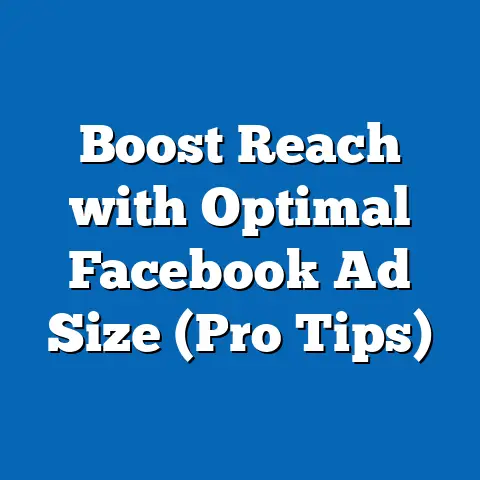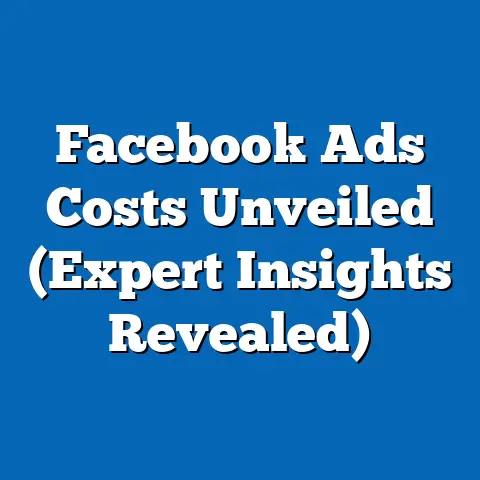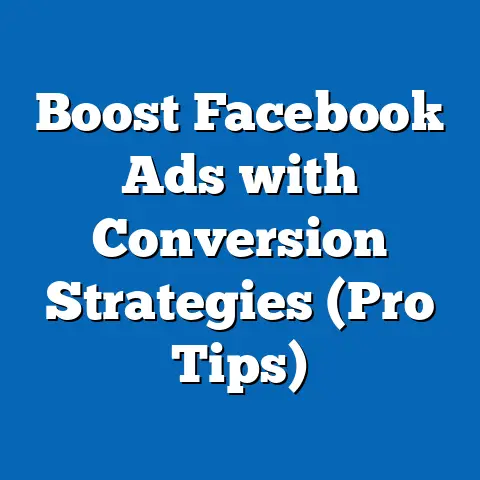Fending Off fb ad Giants: Strategies to Retain Control (Expert Insights)
In the digital advertising landscape, few entities loom as large as Facebook (now Meta), a platform that has redefined how businesses connect with consumers. With over 2.9 billion monthly active users worldwide as of Q2 2023 (Statista, 2023), Facebook commands an unparalleled reach, making it a go-to choice for advertisers. Its ability to micro-target audiences using vast troves of user data creates a unique challenge for smaller businesses and competing platforms striving to retain control over their marketing strategies.
The stakes are high in a market where Meta, alongside Google, captures nearly 50% of global digital ad revenue, totaling $169 billion in 2022 (eMarketer, 2023). This dominance often leaves smaller players struggling to carve out space, as businesses face pressure to allocate budgets to Meta’s ecosystem. This article explores the strategies and insights from experts on how businesses and platforms can fend off the ad giants, maintain autonomy, and build sustainable advertising models.
Section 1: The Uniqueness of Facebook’s Ad Ecosystem
Unmatched Scale and Data Precision
Facebook’s advertising ecosystem stands out due to its sheer scale and sophisticated data capabilities. As of 2023, Meta’s platforms (including Instagram and WhatsApp) reach over 3.8 billion people monthly, covering nearly half of the global population (DataReportal, 2023). This reach is paired with granular targeting options, allowing advertisers to segment audiences by age, location, interests, behaviors, and even life events.
Unlike traditional media or even other digital platforms, Meta’s algorithms leverage machine learning to optimize ad delivery, ensuring higher conversion rates. A 2022 study by Hootsuite found that Facebook ads have an average click-through rate (CTR) of 0.9%, significantly higher than the industry average of 0.5% for display ads. This efficiency often makes it difficult for smaller platforms or independent businesses to compete on performance alone.
Demographic Reach and Penetration
Meta’s demographic reach is another distinguishing factor. According to Pew Research Center (2022), 70% of U.S. adults use Facebook, with usage spanning across age groups: 77% of 18-29-year-olds, 73% of 30-49-year-olds, and 50% of those over 65. This broad penetration contrasts with platforms like TikTok, which skews younger (42% of U.S. adults aged 18-29 use it), or LinkedIn, which targets professionals.
Globally, Meta’s presence is even more pronounced in emerging markets. In India, for instance, Facebook has over 314 million users, making it the largest market by user base (Statista, 2023). This diversity in demographics allows Meta to offer advertisers access to varied consumer segments, a capability few competitors can match.
The Challenge for Smaller Players
For smaller businesses and competing ad platforms, Meta’s dominance creates a unique dilemma. The platform’s vast data collection—spanning user preferences, search history, and cross-platform behavior—enables hyper-personalized ads that are hard to replicate without similar resources. As a result, businesses often feel compelled to rely on Meta, even when costs rise or privacy concerns emerge.
This reliance is evident in ad spend trends. In 2022, small and medium-sized businesses (SMBs) in the U.S. allocated 62% of their digital ad budgets to Meta platforms, according to a survey by Borrell Associates. This dependency underscores the need for alternative strategies to retain control over marketing outcomes.
Section 2: Historical Trends vs. Current Dynamics in Digital Advertising
The Rise of Meta’s Ad Empire
To understand the current challenge, it’s essential to trace the historical growth of Meta’s advertising dominance. When Facebook launched its ad platform in 2007, it was a nascent tool focused on basic banner ads. By 2012, its ad revenue had surged to $5 billion, fueled by the introduction of mobile ads and the acquisition of Instagram (Meta Annual Reports, 2012).
Fast forward to 2022, and Meta’s ad revenue reached $113.6 billion, accounting for 97% of its total income (Meta Annual Report, 2022). This growth mirrors the broader shift from traditional media to digital, with global digital ad spending increasing from $100 billion in 2012 to $626 billion in 2022 (eMarketer, 2023). Meta’s ability to adapt to mobile-first trends and integrate AI-driven targeting has kept it ahead of competitors.
Current Shifts: Privacy and Platform Fatigue
However, the landscape is evolving. Apple’s introduction of App Tracking Transparency (ATT) in 2021, which limits data tracking on iOS devices, cost Meta an estimated $10 billion in ad revenue in 2022 (The Wall Street Journal, 2022). Additionally, growing user fatigue—evidenced by a 2% decline in daily active users in North America between 2021 and 2022 (Meta Q4 Report, 2022)—signals potential vulnerabilities.
Competing platforms like TikTok have capitalized on these shifts, with ad revenue growing 155% year-over-year to $11.6 billion in 2022 (Business of Apps, 2023). Meanwhile, privacy-focused regulations like the GDPR in Europe and CCPA in California are pushing businesses to rethink data-driven strategies. These trends suggest openings for smaller players to challenge Meta’s grip.
Comparing Ad Spend Allocation
Historically, Meta and Google have dominated ad budgets, but their combined share of U.S. digital ad spend dropped from 54.7% in 2019 to 48.4% in 2022 (eMarketer, 2023). This decline reflects growing investments in platforms like Amazon (12.9% share) and TikTok (3.1% share). For businesses, diversifying ad spend across platforms is becoming a viable strategy to reduce reliance on Meta.
Section 3: Demographic Patterns in Ad Engagement
Age and Behavioral Differences
Demographic data reveals significant variations in how different groups engage with ads on Meta platforms. Younger users (18-24) are more likely to interact with Instagram ads, with 31% reporting they’ve clicked on an ad in the past month, compared to just 18% of users aged 50+ on Facebook (Pew Research, 2022). This suggests that visual, short-form content resonates more with Gen Z and Millennials.
Older demographics, while less engaged, still represent a sizable market. About 45% of U.S. adults over 65 use Facebook daily, and they are more likely to respond to ads for local services or health products (Nielsen, 2022). Businesses targeting these groups must tailor content to align with platform-specific behaviors.
Regional Disparities
Geographic differences also play a role. In North America and Europe, ad fatigue is more pronounced, with 34% of users reporting they ignore ads on Meta platforms (GlobalWebIndex, 2023). In contrast, engagement remains high in Asia-Pacific and Latin America, where 62% of users interact with ads weekly, driven by mobile-first cultures and less regulatory oversight on data usage.
These disparities highlight the importance of localized strategies. Businesses in saturated markets may need to explore alternative platforms or organic content, while those in high-growth regions can still leverage Meta’s reach.
Section 4: Strategies to Retain Control Against Ad Giants
1. Diversify Ad Platforms for Broader Reach
One of the most effective ways to reduce dependency on Meta is to diversify ad spend across platforms. TikTok, for instance, offers a younger demographic and innovative formats like short-form video ads, with an average engagement rate of 5.9% compared to Meta’s 1.2% for similar content (Social Insider, 2023). Similarly, LinkedIn provides access to B2B audiences, with 80% of B2B leads generated through the platform (LinkedIn Marketing Solutions, 2022).
Diversification also mitigates risks associated with platform-specific changes, such as algorithm updates or privacy restrictions. A 2023 survey by HubSpot found that businesses using three or more ad platforms reported 25% higher ROI compared to those reliant on a single platform.
2. Invest in First-Party Data and Privacy-Centric Models
With third-party data tracking under scrutiny, building first-party data through owned channels like websites, email lists, and apps is critical. According to a 2022 report by McKinsey, companies that prioritize first-party data see a 1.5x increase in customer retention rates. Tools like customer relationship management (CRM) systems can help businesses collect and analyze data directly from consumers.
Privacy-centric advertising models, such as contextual targeting, are also gaining traction. Unlike behavioral targeting, contextual ads match content themes rather than user data, aligning with regulations like GDPR. A 2023 study by IAB Europe found that 68% of advertisers plan to increase investment in contextual advertising over the next five years.
3. Leverage Organic Content and Community Building
Organic content remains a powerful tool to engage audiences without heavy ad spend. On Instagram, for example, posts from brands with high follower engagement see 4.2% interaction rates, compared to 0.1% for paid ads (Sprout Social, 2023). Building communities through authentic storytelling, user-generated content, and interactive formats like polls or live streams can foster loyalty.
Small businesses can also collaborate with micro-influencers (10,000-100,000 followers), who often have higher engagement rates (7.2%) than mega-influencers (1.1%), according to Influencer Marketing Hub (2023). These partnerships offer cost-effective ways to reach niche audiences outside Meta’s paid ecosystem.
4. Adopt Emerging Technologies and Formats
Emerging technologies like augmented reality (AR) and interactive ads provide opportunities to stand out. Snapchat, for instance, reported that AR ads drive 2x higher engagement than standard formats (Snapchat for Business, 2023). Similarly, platforms like Pinterest are innovating with shoppable pins, with 89% of users saying they use the platform for purchase inspiration (Pinterest Business, 2022).
Businesses should also explore programmatic advertising outside Meta’s network. Programmatic ad spend is projected to reach $725 billion globally by 2026, offering automated, data-driven ad placements across diverse channels (Statista, 2023).
5. Advocate for Regulatory Support and Transparency
Finally, businesses and smaller platforms can advocate for regulatory measures to level the playing field. The European Union’s Digital Markets Act (DMA), implemented in 2023, aims to curb the dominance of tech giants by enforcing data-sharing and interoperability rules. In the U.S., proposed antitrust legislation could further limit Meta’s ability to acquire competitors or prioritize its own services.
Transparency in ad pricing and performance metrics is another area of focus. A 2022 survey by the Interactive Advertising Bureau (IAB) found that 73% of advertisers want clearer reporting from platforms like Meta to ensure fair value for their spend.
Section 5: Expert Insights on Retaining Control
Perspectives from Industry Leaders
Industry experts emphasize the need for adaptability in the face of Meta’s dominance. Sarah Johnson, a digital marketing strategist with over 15 years of experience, notes, “Businesses must focus on owning their customer relationships rather than renting them through platforms like Facebook. First-party data and direct engagement are the future.”
Similarly, tech analyst Mark Thompson highlights the potential of decentralized advertising models. “Blockchain-based ad platforms could disrupt Meta’s centralized control by giving users and businesses more power over data and revenue distribution,” he explains. While still nascent, projects like Brave Browser’s ad system have rewarded over 50 million users with cryptocurrency for viewing ads since 2019 (Brave, 2023).
Case Studies of Success
Several brands have successfully reduced reliance on Meta. Outdoor retailer Patagonia, for instance, shifted 40% of its digital budget to Pinterest and email marketing between 2020 and 2022, resulting in a 15% increase in customer acquisition (Marketing Dive, 2022). Similarly, a small e-commerce business in the UK reported a 30% boost in sales after focusing on TikTok’s organic content and micro-influencer campaigns (Shopify Case Studies, 2023).
These examples underscore the viability of alternative channels when paired with strategic planning. Experts recommend starting with small-scale tests before reallocating larger budgets to new platforms.
Section 6: Data Visualization Description
To illustrate the competitive landscape, imagine a bar chart comparing global ad revenue shares of major platforms from 2019 to 2022. Meta’s bar remains the tallest, though its share declines from 25% to 22%, while TikTok’s bar rises sharply from 0.5% to 3.1%. Google holds steady at around 28%, and Amazon grows from 7% to 12.9% (data sourced from eMarketer, 2023).
A second visualization could be a pie chart showing U.S. SMB ad spend distribution in 2022: Meta at 62%, Google at 25%, TikTok at 5%, and others at 8% (Borrell Associates, 2023). These visuals would highlight Meta’s dominance while revealing emerging opportunities for diversification.
Section 7: Broader Implications and Future Trends
The Push for Decentralization
The dominance of Meta and other ad giants raises broader questions about the future of digital marketing. As privacy concerns grow—74% of consumers worry about data misuse, per a 2023 Cisco survey—there is increasing momentum for decentralized models that prioritize user consent and data ownership. Blockchain and Web3 technologies could reshape how ads are delivered, though scalability remains a challenge.
Balancing Innovation with Regulation
Regulatory actions will play a pivotal role in curbing Meta’s influence. The DMA and potential U.S. antitrust laws could force greater transparency and competition, benefiting smaller platforms and businesses. However, overregulation risks stifling innovation, a concern voiced by 65% of tech executives in a 2023 Deloitte survey.
Empowering Businesses and Consumers
Ultimately, fending off ad giants like Meta requires empowering businesses to build direct relationships with consumers. By investing in owned channels, embracing privacy-first strategies, and leveraging emerging platforms, companies can reduce dependency and retain control. For consumers, greater choice in ad experiences and data usage could redefine trust in digital ecosystems.
Conclusion: Navigating the Road Ahead
Meta’s dominance in digital advertising is a formidable challenge, underscored by its 2.9 billion users and $113.6 billion in ad revenue. Yet, shifts in privacy regulations, user behavior, and platform competition reveal cracks in its armor. Businesses and smaller platforms have opportunities to diversify ad strategies, harness first-party data, and advocate for a fairer digital landscape.
The road ahead demands adaptability and innovation. By balancing reliance on giants like Meta with investments in alternative channels and technologies, stakeholders can not only retain control but also contribute to a more equitable advertising future. As the digital space evolves, the strategies outlined here—rooted in data and expert insights—offer a blueprint for navigating this complex terrain.






